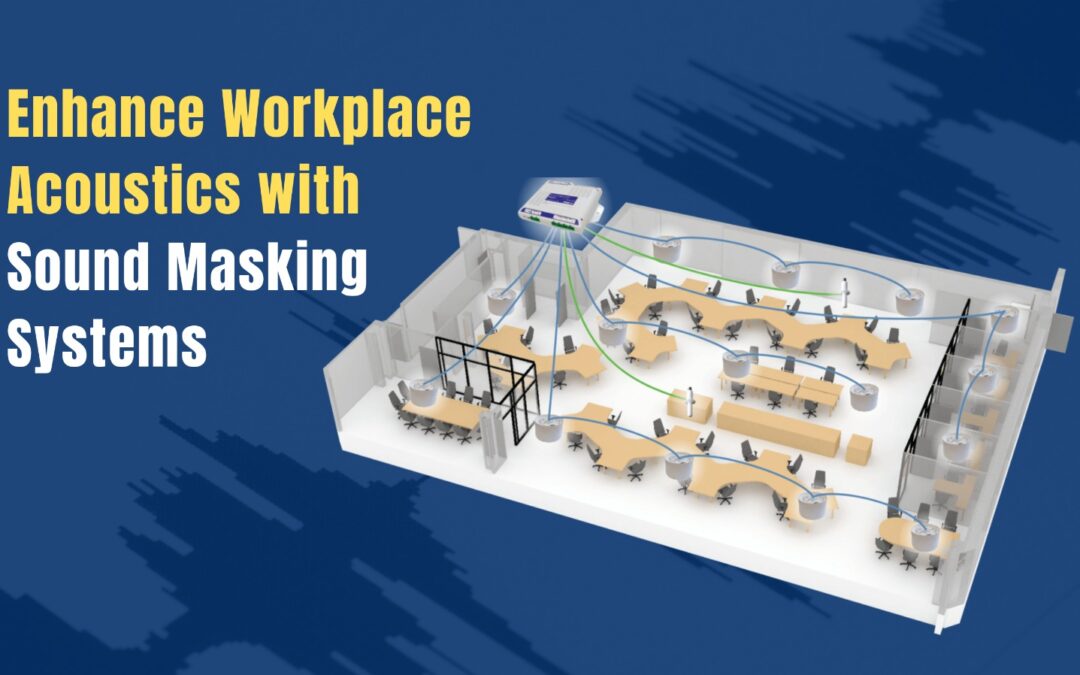In today’s fast-paced and open-office work environments, managing ambient noise levels is critical for ensuring employee comfort and productivity. This is where sound masking systems come into play. As a senior SEO manager, I understand the significance of optimizing workplace acoustics to boost employee well-being and overall performance. In this blog, we’ll delve into the concept of sound masking and explore the different types of sound masking system available to create an ideal auditory environment.
Understanding Sound Masking
Sound masking is a technique employed to reduce the perceived volume of ambient noise in a given space by introducing a low-level, unobtrusive background sound. This background sound, commonly referred to as “white noise,” is specifically designed to blend with surrounding noises and create a more comfortable and private acoustic environment.
The primary objective of sound masking is not to eliminate all sounds but to minimize speech intelligibility and reduce distractions, ultimately enhancing speech privacy and concentration in shared workspaces. By doing so, sound masking system can lead to increased productivity, improved communication, and a more comfortable work atmosphere.
Types of Sound Masking Systems
- Analog : Analog sound masking systems are the traditional approach to sound masking and are often used in small to medium-sized offices. They consist of a central control unit that generates the masking sound and distributes it through speakers placed in the ceiling or walls. These systems are relatively simple to install and operate, making them a cost-effective solution for smaller spaces.
- Networked : Networked sound masking systems are more advanced and versatile compared to their analog counterparts. These systems leverage the power of digital technology to create sound zones, allowing for precise control over the volume and distribution of the masking sound. Networked systems can be easily integrated with existing building management systems, making them ideal for larger office spaces and complex environments.
- Direct Field : Direct field sound masking system employ small, unobtrusive speakers installed in the workspace, typically above workstations or along the walls. Unlike traditional ceiling-mounted systems, direct field systems target the sound directly at the occupants, ensuring a more effective and efficient masking experience. These systems work well in open-plan offices or spaces with high ceilings.
- For Open Offices: Open office layouts are notorious for their noise-related challenges. Sound masking systems specifically designed for open offices help create a more comfortable and acoustically balanced environment. These systems take into account the unique architectural characteristics of open offices to provide uniform masking coverage and improved speech privacy.
- Adaptive: Adaptive sound masking systems use intelligent algorithms to adjust the masking sound level in real-time based on ambient noise conditions. These systems can detect changes in noise levels and automatically adapt the masking sound to maintain an optimal and consistent soundscape. This ensures that the system remains effective even in dynamic environments.
Benefits of Sound Masking Systems
- Enhanced Speech Privacy: Sound masking prevents conversations from being overheard, enhancing speech privacy and confidentiality in sensitive work settings.
- Reduced Distractions: By minimizing the intelligibility of background conversations and other noises, sound masking system reduce distractions, allowing employees to stay focused on their tasks.
- Increased Productivity: A more comfortable and quieter workspace leads to improved concentration and productivity, as employees can work without constant interruptions.
- Employee Well-being: A well-controlled acoustic environment contributes to employee satisfaction, reducing stress levels and promoting overall well-being.
- Flexibility: Different types of sound masking system cater to various office layouts and sizes, making them flexible and suitable for a wide range of applications.
Conclusion
Sound masking systems offer an effective solution to manage ambient noise levels and create a more comfortable and productive workspace. By choosing the right type of sound masking system for your office’s unique needs, you can foster a conducive work environment that benefits both your employees and your business.Remember, a harmonious acoustic setting leads to better focus, clearer communication, and ultimately, greater success for your organization. Embrace sound masking technology and witness the positive impact it can have on your workplace dynamics.

